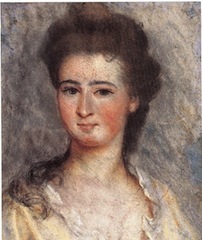Although a little girl is, in fact, shown sitting on a chair in this painting, it was one of the pictures I had in mind when I invented Jeanette’s interest in rooms as “portraits without people.” Anna Ancher, an almost exact contemporary of Jeanette, Read More
Picturing a World
Women Painters of the World (1905)
April 6, 2014
Web link: Check out the website of The Public Domain Review. I immediately found this this book on women painters from 1905, which Mattie my current heroine might give to Jeanette. No telling what what you'll find! Read More
Henrietta Johnston, portraitist
April 4, 2014

Blog tip: For a blog post on the first known American woman portraitist, click here. Always worth keeping an eye on the blog, It's About Time!
Painting Edward’s portrait
April 3, 2014
This painting by Jeanna Bauck (1840-1926) depicts a fancier, better equipped studio than Jeanette’s, but you can imagine my excitement when I found it last year—the right era, a woman assiduously painting a portrait of a sober-faced older man. Read More
This not an April Fool …
April 1, 2014
This is not an April Fool’s joke, but a genuine double-page spread. Anyone care to speculate on the sex of author and illustrator?
Copies and what came after
March 31, 2014
Art students in the 19th C studied older artists’ paintings by copying them,Velázquez being a favorite. Many continued the practice throughout their careers. The work of Jeanette’s contemporary, Finnish artist Helene Schjerfbeck (1862-1946), shows how interesting the copies could be and how different their original work eventually became. Read More
Class critique
February 3, 2014
I recently came across this picture by Albert Guillaume. William Adolphe Bouguereau criticizing student work in Jeanette’s class at the Académie Julian? Not quite, but mighty close! It appears in the January 14, 1905, issue of the French weekly, L’Illustration, accompanying the magazine’s review of a play, La Massière by Jules Lemaître. Read More
Cassatt's blue chair
December 5, 2013
I had Jeanette and Edward react to Mary Cassatt’s Portrait of a Little Girl at the 4th Impressionist Exhibition for several reasons. First and obviously, it fell in with a focus on women painters. Second, the tilting of the picture plane, influenced by Japanese woodcuts, was an important upending of pictorial convention at the time, and I wanted to show how the older Edward could in some ways be more open to the avant-garde than a typical art student like Jeanette who was invested in the prevailing conventions at the very time they were about to fall. Read More
Lucy Lee Robbins
October 14, 2013
The character Lucille Dobbs is based only very loosely on this portrait of Lucy Lee Robbins, an American who studied with Carolus-Duran in the 1880’s. Although Robbins was considered for the prize of painting a mural in the Women’s Building at the Chicago World’s Fair of 1893, she was said by Mrs. Palmer Potter to be “not above reproach” Read More
Red Rose Girls
September 9, 2013
After Saturday's blog alert on moving pictures, here's a still that tickled me while I was writing Where the Light Falls. Although I wanted events in my novel to be accurate to 1878–1880, not everything that inspired me came from that period. The camaraderie, humor, and tensions of a shared studio as well as the fruitfulness of women’s friendship were exemplified by the three women artists shown in this photograph. Jeanette's somewhat younger contemporaries, they began living together in 1899 and called themselves the Red Rose Girls. Read More








